Flowers covered both the bushes that gave structure to the heathland habitat - here, the orange blooms of Sticky Eremaea - and the ground beneath (in this photo, a stand of trigger plants).
Alexander Morrison National Park may be among the few in the world that have been saved by their own plant life. The area is rich in poison peas (Gastrolobium spp), plants so toxic to livestock that the area was never cleared.
The plants of the shrub layer included featherflowers (Verticordia spp) in abundance. Verticordia has radiated into a huge number of species in Western Australia (with at least fifteen in the area of the park), each seemingly more beautiful and exotic-looking than the next. All of them, at least to my knowledge, set off their flowers with the fringed ruff of sepals that gives them their common English name. This beautiful example appears to be Compacted Featherflower (Verticordia densiflora), a widespread and variable southwestern species.
This one may be Verticordia ovalifolia, not yet in full bloom.
This peculiar-looking verticordia, obviously not at its floral best, might be Variegated Featherflower (V. huegelii), or just an odd-looking example of the next species.
Certainly one of the most startling of the genus is the Scarlet Featherflower (Verticordia grandis), a fairly local plant of the Kwongan. There are bright yellow verticordias too; you can check one of them out in an earlier post.
Though the verticordias were probably the showiest of the myrtles we saw flowering in Alexander Morrison, they were far from the only ones with dense and beautiful arrays of flowers. I am not sure which this one is, but it looks like a featherflower without the fringe, so it may be a close relative.
Large-flowered Baeckea (Baeckea grandiflora), if I have identified it correctly, is a common and showy Kwongan species we had already seen many times.
Sticky Eremaea (Eremaea beaufortioides), another species I have featured here before, was particularly abundant in the park (as the photo at the top of this post shows).
Four species of Calothamnus have been recorded from the area. Long-leaved Clawflower (C. longissimus) is a local Kwongan specialty.
Silky-leaved Bloodflower (Calothamnus sanguineus), on the other hand, ranges along much of the southwestern coast.
On to the Proteaceae: the remarkable inforescences of Yellow Plume or Flame Grevillea (Grevillea eriostachya), borne on long, spindly branches, made an arresting addition to the otherwise rounded and compact-looking profile of the park's vegetation.
The displays of Grevillea shuttleworthiana were altogether more sedate.
Hooker's Banksia (Banksia hookeriana), a very local species, is a winter bloomer that seemed to have finished flowering, leaving behind only the dry remains of its floral columns.
Hakeas vary tremendously in leaf shape and form. Needle Tree (Hakea psilorrhyncha), another Kwongan specialty, belongs to a group of dry-adapted hakeas with simple, thickened leaves tipped (as the name implies) with needle-like points.
We continue our Parade of Proteas with another limited-range species, the Pine-Cone Petrophile (Petrophile conifera)....
... and the Sickle-leaved Coneflower (Isopogon linearis), another Kwongan specialty, and a particularly beautiful one.
Filling out our array of proteas are less typical-looking plants: Blueboy (Stirlingia latifolia)...
... and the ever-present smokebushes (Conospermum spp).
As for flowers other than myrtles and proteas, we continued to see the purple-blue flowers of dampieras (Dampiera sp)...
...as well as a number of other things that I have failed to identify...
and a few I did figure out, including Golden Long-Heads (Podotheca gnaphalioides).
Grass-trees punctuated the heathland growth in many places along our route. Based purely on range, this could be Xanthorrhoea drummondii.
The tiny object I am making such efforts to photograph here is a trigger plant (Stylidium sp). I continued to find these plants, with their snap-trap pollination mechanisms, fascinating things.
Identifying, them, though, is a frustrating experience. At least twenty species are known from the area around Alexander Morrison. This one may be Stylidium albolilacinum, whose flowers range from white to violet (thereby confusing me still further).
As you can see, the flowers I photographed varied quite a bit in intensity of colour; are they just variants of the same species?
These two, though, differ in shape and pattern as well as colour. The lower one may be Matted Triggerplant (Stylidium repens), a widespread and common species. Maybe. Next time I come here (should I be so fortunate) I will try to include a botanist in my luggage.









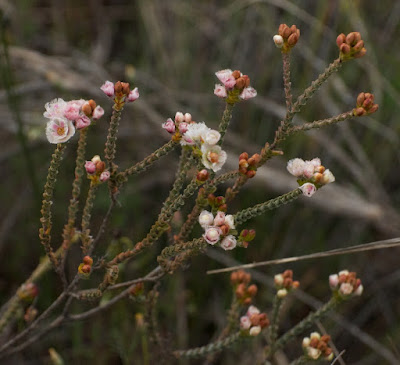


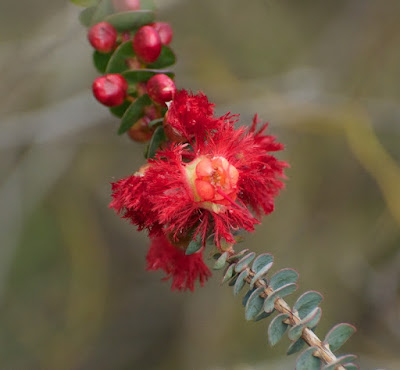

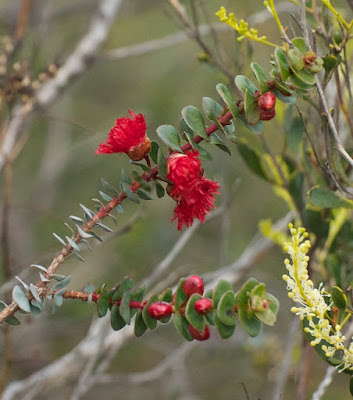





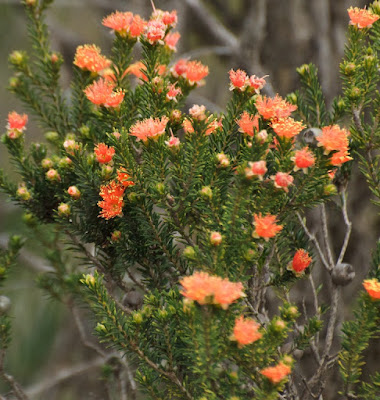













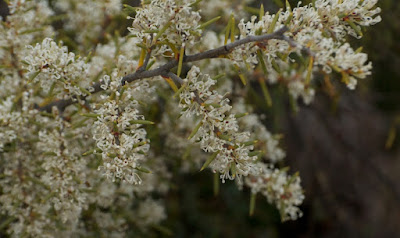




















No comments:
Post a Comment